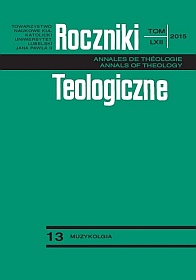Musical Works of Father Eustachius Wagner (1714–1782) from Krzeszów in the Light of The Litany in Honour of St. Joseph
Abstract
Fr. Eustachius Wagner’s musical activities with his work as a composer is closely related to the musical and liturgical centre of the Cistercian abbey in Krzeszów. Accordingly, the music is inspired by the native trends. Furthermore, in terms of the music style, it refers to the period of the so-called Early Classicism, also called the pre-Classicism period. Fr. Eustachius Wagner lived between 1714–1782. He was born in Nowy Waliszów near Bystrzyca Kłodzka. He joined the Cistercian order in the monastery of Krzeszów, where he spent most of his life. He became famous as an excellent organist, cantor, conductor and composer. He used to collaborate with many other music centres in Silesia and in Europe. He composed polyphonically—for the purpose of the music band in Krzeszów—Marian antiphons, the Litany of Saint Joseph, Requiem Mass, and the offertory for the feast of Our Lady. Lytaniae ex D de Santco Jospeho was written between 1730 and 1782. It was earmarked for the band of Krzeszów on a four-voice choir, two violins, two trumpets and the organ. The litany consists of five parts, which differ among one another, primarily in terms of tone, tempo and arrangements. In order to highlight certain elements of the text, the composer applied various composition techniques, among which rhetorical figures deserve special recognition.
References
Anonimus. Litaniae ex C de Sancto Josepho. BKrz. Rps V–107.
Anonimus. Litaniae ex D de Sancto Josepho. BKrz. Rps V–112.
Dębski, Piotr. “Przygotowanie i realizacja prac konserwatorskich przy zabytkowych organach Michaela Englera w bazylice p.w. Wniebowzięcia Najświętszej Maryi Panny w Krzeszowie” [Preparation and Implementation of Conservation Work on Historic Organs of Michael Engler in the Basilica Church of Assumption of the Blessed Virgin Mary in Krzeszów]. In Organy Michaela Englera w bazylice p.w. Wniebowzięcia Najświętszej Maryi Panny w Krzeszowie [The Organs of Michael Engler in the Basilica Church of the Assumption of the Blessed Virgin Mary in Krzeszów], edited by Piotr Grinholc, 5–13. Krzeszów: Wydawnictwo Muzyczne Triangiel, 2008.
Dola, Kazimierz. “Krzeszów cysterski – Krzeszów benedyktyński (1242-1946)” [Cistercian Krzeszów – Benedictine Krzeszów (1242-1946)]. In Perspectiva. Legnickie Studia Teologiczno-Historyczne [Perspectiva. Theological-Historical Studies in Legnica], 1(2002) 1: 40–60.
Górniak, Marek R. “Krzeszów.” In Encyklopedia Katolicka [The Catholic Encyclopedia], edited by Andrzej Szostek and Bogusław Migut, vol. 9. Lublin: Towarzystwo Naukowe KUL, 2002, 1447.
Ivanschitz, Amandus. Litaniae ex C de Sancto Josepho. BKrz. Rps. BKrz. Rps V-50 (Biblioteka Sióstr Benedyktynek w Krzeszowie).
Kudera, Dorota and Mariola Malerek. Krzeszów. Piechowice, 1997.
Kutrowski, Łukasz. “Lytaniae ex D de Sancto Josepho” o. Eustachiusa Wagnera O. Cist. jako przejaw kultu św. Józefa w dawnym opactwie cystersów w Krzeszowie” [“Lytaniae ex D de Sancto Josepho” by Fr. Eustachius Wagner, Cisterian, as a Manifestation of the Cult of St. Joseph, a former Cistercian abbey in Krzeszów]. Phd diss., John Paul II Catholic University of Lublin, 2014.
Pośpiech, Remigiusz. Muzyka wielogłosowa w celebracji eucharystycznej na Śląsku w XVII i XVIII wieku [Polyphonic Music in Celebration of the Eucharist in Silesia in the Seventeenth and Eighteenth Centuries]. Opole: Wydział Teologiczny Uniwersytetu Opolskiego, 2004.
Pośpiech, Remigiusz. “Wkład cystersów w rozwój kultury muzycznej Śląska [Cistercian Contribution to the Development of The Musical Culture of Silesia”]. In Johannes Nucius. Epoka, duchowość, życie i twórczość. Materiały z Konferencji Naukowej zorganizowanej z okazji 450-lecia urodzin Johannesa Nuciusa, opata cysterskiego w Jemielnicy, kompozytora i teoretyka muzyki w Kamieniu Śląskim dnia 11 października 2006 roku [Johannes Nucius. Epoch, Spirituality, Life and Work. Proceedings of the Scientific Conference organized on the occasion of the 450th Anniversary of the Birth of Johannes Nuciusa, the Cistercian Abbot of Jemielnica, A Composer and Music Theorist in Kamień Śląski on 11 October 2006], edited by Remigiusz Pośpiech and Piotr Tarliński, 185–212. Opole, 2008.
Rose, Ambrosius. Profeßbuch von Grüssau. Leben und Wirken der Ziesterzienser 1292-1810. Köln, 1990.
Sailer, Stephan. Litaniae ex C de Sancto Josepho. BKrz. Rps V–75.
Walter, Rudolf. “Grüssau.” In Schlesisches Musiklexikon, edited by Lothar Hoffmann-Erbrecht. Augsburg, 2001.
Walter, Rudolf. Musikgeschichte des Zistersienserklosters Grüssau. Von Anfang des 18. Jahrhunderts bis zur Aufhebung im Jahre 1810. Kassel, Basel, London, New York, Prague, 1996.
Wolnik, Franciszek. “Cystersi w Europie” [Cistercians in Europe]. In Johannes Nucius. Epoka, duchowość, życie i twórczość. Materiały z Konferencji Naukowej zorganizowanej z okazji 450-lecia urodzin Johannesa Nuciusa, opata cysterskiego w Jemielnicy, kompozytora i teoretyka muzyki w Kamieniu Śląskim dnia 11 października 2006 roku [Johannes Nucius. Epoch, Spirituality, Life and Work. Proceedings of the Scientific Conference organized on the occasion of the 450th Anniversary of the Birth of Johannes Nuciusa, the Cistercian Abbot of Jemielnica, A Composer and Music Theorist in Kamień Śląski on 11 October 2006], edited by Remigiusz Pośpiech and Piotr Tarliński, 55. Opole, 2008.
Zawistowski, Piotr. Rozważania na temat retoryki w muzyce baroku [Considerations on Rhetoric in Baroque Music], 14–21. Accessed May 20, 2014, http://chopin.man.bialystok.pl.
Copyright (c) 2015 Roczniki Teologiczne

This work is licensed under a Creative Commons Attribution-NonCommercial-NoDerivatives 4.0 International License.





